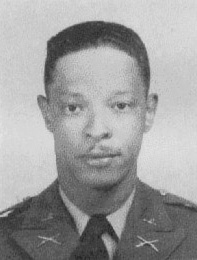366th Infantry Regiment (United States) facts for kids
Quick facts for kids 366th Infantry Regiment |
|
|---|---|
| Active | November 1917–25 March 1919 10 February 1941-28 March 1945 |
| Country | |
| Branch | United States Army |
| Type | Infantry |
| Size | Regiment |
| Garrison/HQ | Fort Devens, Massachusetts |
| Motto(s) | "Labor Conquers All Things." |
| Engagements | World War I, World War II |
| Battle honours | Meuse-Argonne Offensive, Rome-Arno Campaign |
The 366th Infantry Regiment was a special unit of the United States Army. It was made up entirely of African Americans, meaning it was a segregated unit. This regiment served in both World War I and World War II. What made it very unique in World War II was that all of its officers, as well as its soldiers, were Black. At that time, the U.S. military was still segregated and did not allow Black and White soldiers to serve together in the same units until after World War II.
Contents
The 366th Infantry in World War I
The 366th Infantry Regiment was officially formed on August 16, 1917. It became part of the 92nd Division and was organized at Camp Dodge, Iowa, in November 1917.
During World War I, the regiment was sent overseas to fight. It was part of the 92nd Division, which was a unit of the National Army. The 366th Infantry earned recognition for its bravery in several battles:
- St. Die Sector (Lorraine): From August 23 to September 20, 1918.
- Meuse-Argonne Sector: From September 26 to October 5, 1918.
- Marbach Sector (Lorraine): From October 8 to November 1918.
After the war, the 366th Infantry was officially ended on March 25, 1919, at Fort Oglethorpe, Georgia. However, it was brought back into service on December 16, 1940, as part of the Regular Army.
The 366th Infantry in World War II
The regiment was reactivated on February 10, 1941, at Fort Devens, Massachusetts. It was first assigned to help protect the Eastern part of the United States.
The 366th Infantry moved to different locations for training and assignments:
- It was attached to the 1st Service Command in May 1943.
- Then, it moved to A. P. Hill Military Reservation, Virginia, in October 1943.
- Later, it went to Camp Atterbury, Indiana, in November 1943.
In March 1944, the regiment left Virginia to go overseas. It arrived in North Africa in April 1944. There, its main job was to guard airfields, from Sardinia all the way to the Adriatic coast.
In November 1944, the 366th Infantry was sent to Italy and joined the 92nd Infantry Division.
Challenges in Combat
When the 366th Infantry arrived in Italy, its commanding officer, Colonel Howard Donovan Queen, felt the unit needed more training for combat. Even though they had been preparing, their long time spent on guard duty meant they weren't fully ready for intense fighting.
Despite these concerns, the 366th Infantry was assigned to the 92nd Division in November 1944. The 92nd Division, which included the 366th, faced many difficulties in combat. Because of these challenges, both German and American commanders thought the division was only suitable for defensive roles.
In early 1945, the 92nd Division was pulled back from the front lines. The 366th Infantry Regiment was officially disbanded in Italy on March 28, 1945. Its soldiers were then transferred to other engineering units.
Notable Veterans of the 366th Infantry
Many brave individuals served in the 366th Infantry Regiment. Some of them went on to achieve great things:
- Edward W. Brooke III: He was the first African American to be elected to the United States Senate after the Reconstruction period. (Served in World War II)
- Frederic E. Davison: He became the first African-American US Army Major General and a division commander. (Served in World War II)
- William L. Dawson: He was the first African American to lead a committee in the United States Congress in 1949. (Served in World War I)
- Aaron R. Fisher: He received the Distinguished Service Cross for his bravery in World War I.
- John R. Fox: He was awarded the Medal of Honor after his death for his actions in World War II.
- James F. Hamlet: He was the second African-American US Army Major General. (Served in World War II)
Regimental Honors and Motto
The 366th Infantry Regiment was honored with two special flags called campaign streamers for its Colors. These streamers recognize their service in important campaigns:
- Meuse-Argonne Lorraine: For their actions from September to November 1918 in World War I.
- Rome-Arno: For their service from January to September 1944 in World War II.
The regiment's symbol, the Regimental Shield, included the Cross of Lorraine. Their motto was, "Labor Conquers All Things." This means "Hard work overcomes all difficulties."
See also
- Military history of African Americans
- Winter Line
- United States Colored Troops



